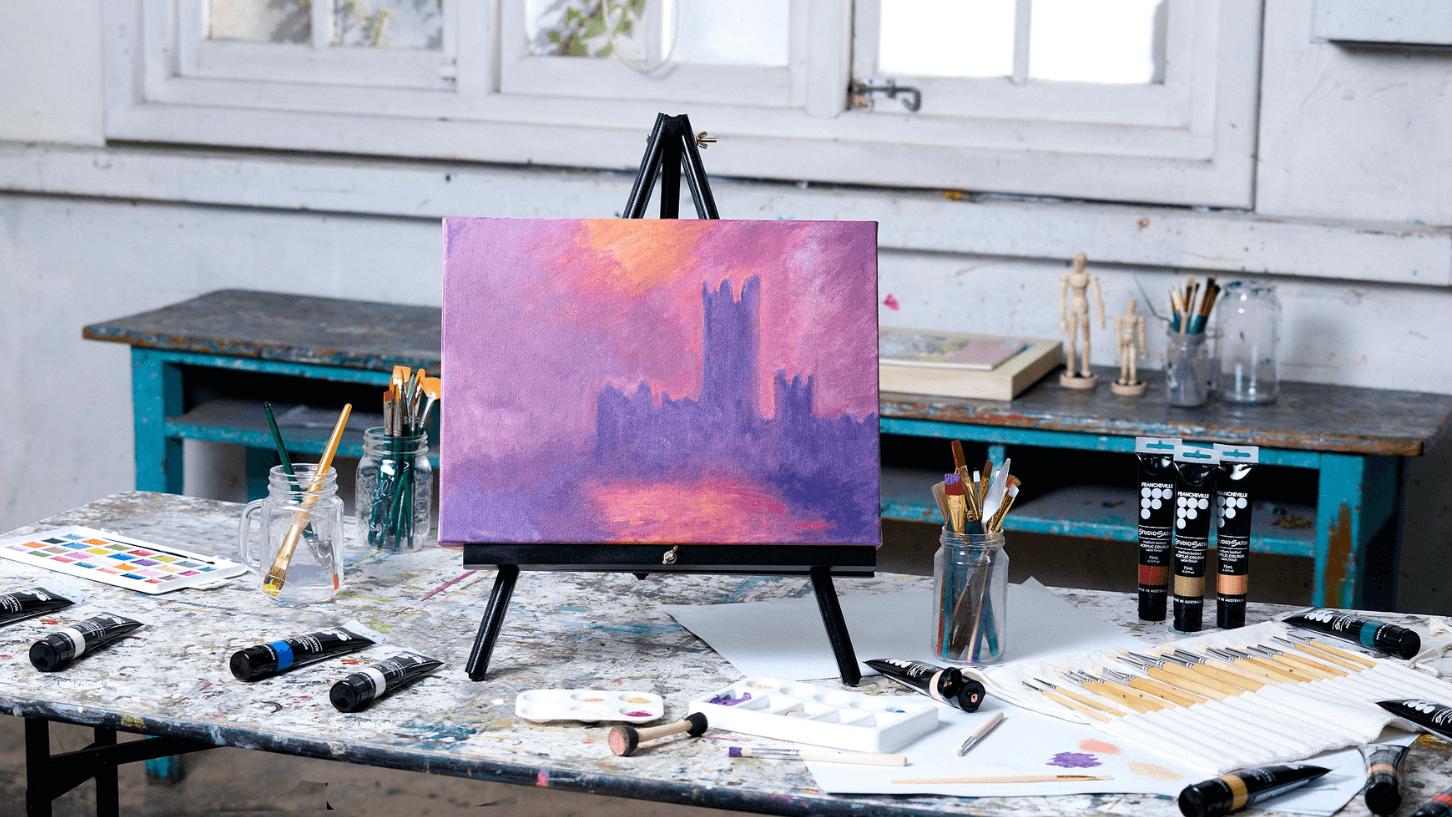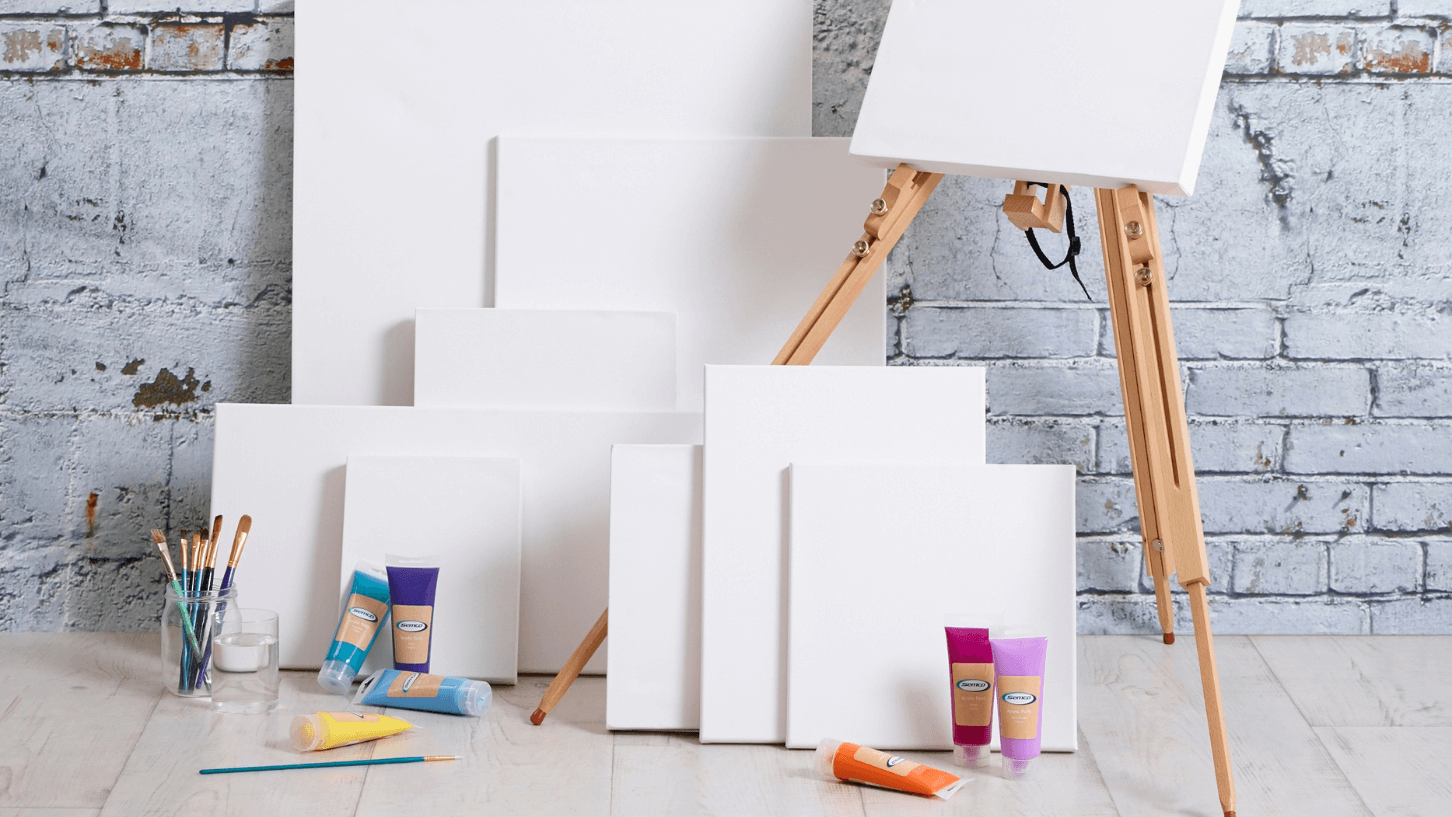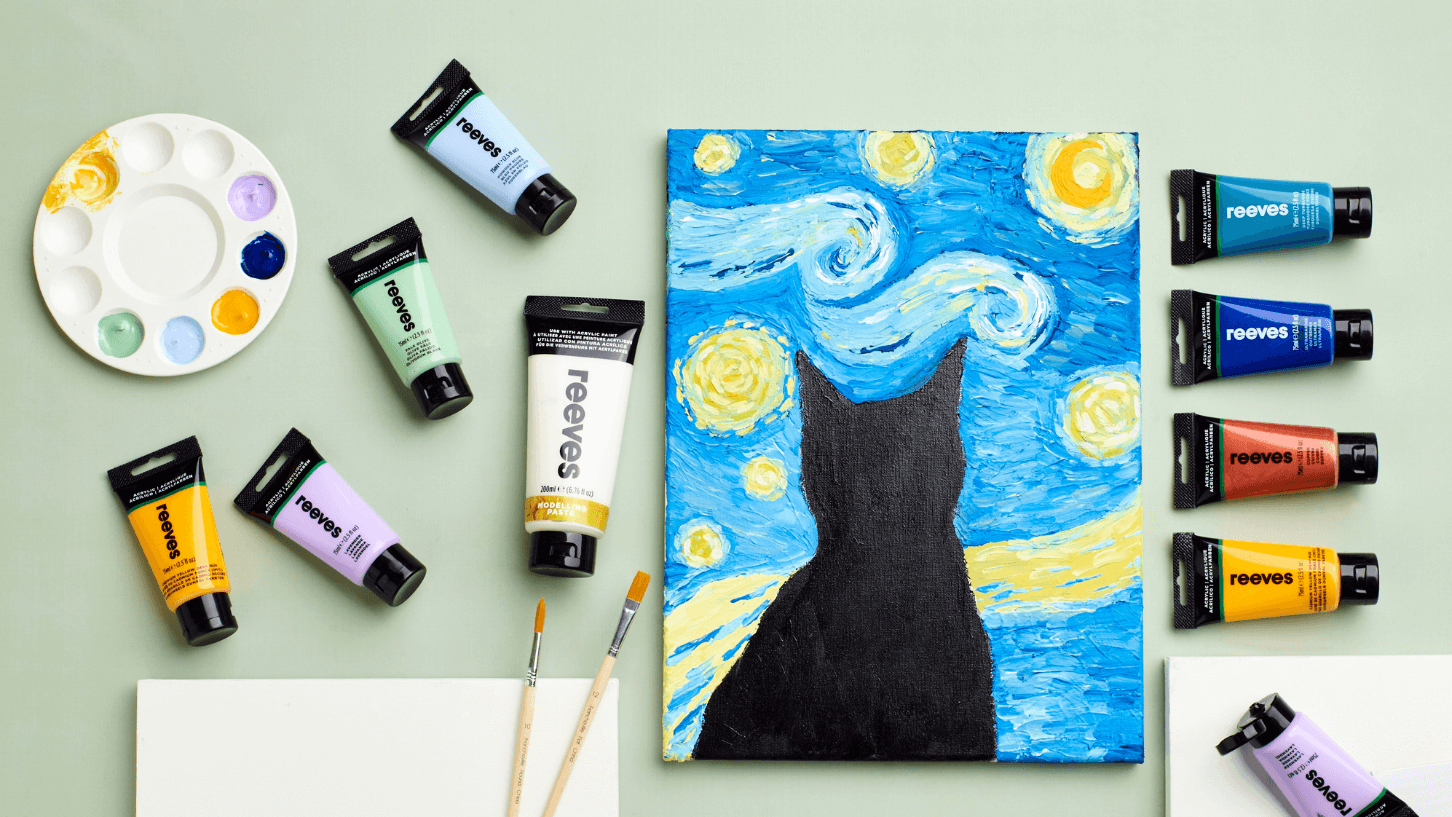 | ||
| Your browser is not supported. | ||
|
Please browse our site using any of the following options:
| ||
How to choose & paint on canvas

If you are confident in painting on paper, then creating your next work of art on a canvas is a challenging but exciting step. Painting on canvas can be quite different to painting on paper, but don't worry - this guide will help you learn all about canvases for art, including what types there are, how to prepare them, how to paint on canvas and which kind is best for you!
What you'll need for canvas painting
If you have a canvas suitable for painting straight onto, there are a few things you'll need to get started:
- Oil paints, acrylic paints and watercolour paints are all suitable for use on canvas, but make sure you choose a canvas that has been specially prepared for the kind of paint you want to use.
- Palette - keep your paints within easy reach on a paint palette. If you are painting on a larger canvas, make sure you have a palette you can hold comfortably for long periods of time.
- Paintbrushes - have a set of round, flat and filbert-shaped paint brushes in an appropriate material for your paint type.
- Painting knife - because you are working on a large surface, applying paint with a painting knife is a great way to get smooth, creamy colours onto your canvas quickly.
- Easel - rest your canvas at the perfect height and angle on an artist's painting easel. Easels are very important for large canvases, as they let you access and view your whole painting surface easily. Easels can also be used to display a finished painting.

Types of canvas and materials
Canvas for painting is commonly made from cotton, although hardy linen varieties are also sometimes available. Painting canvases come in many varieties, including:
- Rolled canvas - canvas sheets can come in a roll, which means you need to cut and stretch it yourself. This is a cost-effective way to get your hands on canvas, and some artists even prefer to paint on a canvas sheet and then stretch it afterwards.
- Gallery-wrapped canvas - a gallery-wrapped canvas has already been stretched, and the fabric edges wrap totally around the frame so it can't be seen from the front or sides.
- Framed canvas - another pre-stretched canvas, the fabric will have been wrapped around an inner frame and have an exposed, wooden frame visible on the outside.
- Canvas pad - cut into A4 size and bound into a book, canvas pad sheets can be used like paper and are a great way for beginners who want to get a feel for painting on canvas without committing to buying a full canvas.
How to choose a painting canvas for your project
Canvases come in different shapes and sizes and can be primed to suit different paint types. If you have a project in mind but aren't sure what kind of canvas to choose, here are some tips:
- If you are choosing a pre-primed canvas, pick one that has been primed for the paint type you want to use. If you have a canvas labelled 'universal primer' then it is suitable for use with acrylic and oil paints. If it says 'primed for acrylic' or 'primed for oil' then it is best to use the indicated paint - paints will flake off canvases that are not primed to their specifications.
- The shape of a canvas can really influence how your finished painting looks. Traditionally most paintings are done on square or rectangular canvases, as this is an elegant and formal way of presenting your picture. If you are painting a portrait, still life or abstract, a straight-edged canvas is a good way to go.
If you are painting with fluid acrylics (flow art), then a circular canvas is a great alternative. The curved edge, especially when gallery-wrapped, will complement the smooth lines of flow art, and is also great for beachscapes and night scenes.
- If you are thinking of using rough art techniques that involve scraping, a canvas made of linen may be a safer choice. Linen is a tougher material than cotton, but because of its colour will need to be primed to a bright white.
- You should only use a gallery-wrapped canvas if you are planning on painting the sides. This will usually happen automatically if you are using pouring paint as it will flow over the sides as you manipulate the canvas. If you are using traditional paints, you will need to manually fill the gaps with a paintbrush or frame the canvas yourself - leaving the slides blank will make them look empty and forgotten.
How to prime a canvas for painting
It is very important to always paint on a primed canvas. Your colours will be brighter, adhere to the canvas better and last longer, plus it is easier to paint onto a primed canvas than a raw one. Priming for acrylics and oils is different to priming for watercolours - here's how to do both:
Priming a canvas for acrylic and oil paint
You'll need:
- Sandpaper
- Gesso for oil/acrylic paint (stir very well right before using!)
- A wide paintbrush or roller brush
- Water
- Rags or cloth
Either stand your canvas on supports so it doesn't stick to your work area, or move it as you work so it doesn't get stuck!
- You want your gesso to have the consistency of heavy cream. If you need to, you can dilute yours with a bit of water. Use a clean brush or roller to apply the gesso to your canvas in wide strokes, working your way from the top of the canvas to the bottom. If you have a gallery-wrapped canvas, make sure to gesso the edges as well.
- Let the first layer dry - this may take a few hours. Make sure to clean your brush well between uses, as gesso won't come off once it dries!
- To make the surface smoother, give the dried gesso a light sanding.
- When you apply the second coat, paint perpendicular to the first coat you applied.
- Again, let this coat dry and sand if you want a smoother surface.
Priming a canvas for watercolour paint
Priming a canvas for watercolour is not too dissimilar from what we learned above. You'll need to gesso the canvas with two coats and let it dry. After this, you need to apply what is known as watercolour ground. This substance will make the surface of your gessoed canvas more suitable for watercolour paints, making it more absorbent for the watercolour to adhere and spread but not so absorbent that it sinks into the canvas.
Depending on what brand of absorbent ground you buy, you may need to apply multiple layers. Apply them lightly, until the surface of your canvas has reached the paper-like consistency you need!
Tips for canvas painting for beginners

Now you've decided what kind of painting you want to do, found the ideal canvas and primed it to perfection, it's time to paint! Here are our top four tips for canvas painting for beginners:
- Use a painting easel! While it may be tempting just to have your canvas lying flat on a table, larger paintings will be much easier to complete with the help of an easel. The adjustable angle and height mean you will be comfortable painting on even the largest of canvases. And small canvases can benefit from an easel too! Try a table easel for painting while seated, or a travel easel for painting canvas outdoors.
- Paint in a well-ventilated room. Some paints and mediums can smell unpleasant (looking at you, turpentine!) and there are even some that can be dangerous to inhale, like resin fumes. Make sure you have air circulating when you paint and have a mask on hand for any potentially unsafe fumes.
- Create a background colour. You can either mix a bit of acrylic onto your gesso, or just paint a flat layer of paint as a base before you get into any detailed artwork. Painting on a white background is usually fine, but if you are looking to create a piece with a darker tone, having a grey-blue or purple-black tone will help you set the mood you are looking for.
- Sketch your image first. A light drawing using a grey lead pencil or artist's charcoal on the canvas will help you create a more cohesive painting, and acrylic or oil paint will cover light lines completely.
How to care for a canvas painting
Canvas is tougher than paper, but the artwork you make on it is just as susceptible to light, dust and mould as it would be on any other surface. To care for a canvas painting:
- Use a paint varnish or seal your artwork once it has dried. If you want your artwork to last, protecting it is a must. Paint-on and spray-on varnishes both exist, and can add extra effects to your painting like a glossy sheen or UV protection.
- Do not display your canvas in direct sunlight. Even with UV protection, strong sunlight will cause your colours to fade and your canvas to yellow over time.
- When transporting your canvas, make sure it is packed tightly enough that the frame and canvas won't dent, but not so tight that any artwork on the surface is in danger of getting smudged or scratched. Use wax paper as a protective layer on top of the painted side of your canvas, and it should prevent any damage to the artwork.
Find the perfect painting canvas at Spotlight
Are you ready to choose the perfect canvas for your next painting? Check out the range of canvases online, as well as our art supplies. Alternatively, head into your nearest Spotlight store and one of our team members can assist you in finding what you need.
Need a little more help buying the right art supplies? Check out our buying guides on paint mediums and brushes, or browse our paint projects for some inspiration for your next work of art!




